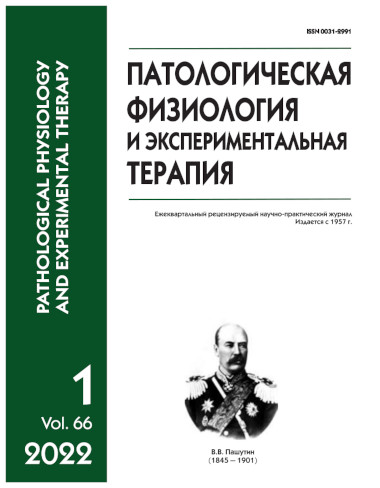The main biochemical markers of non-alcoholic fatty liver disease of various severity (experimental study)
Abstract
Timely diagnosis, treatment, and prophylaxis of non-alcoholic fatty liver disease remain one of the most important medical and social problems in spite of long-standing, extensive studies of the pathogenesis of this disease. A search for an adequate experimental model for non-alcoholic fatty liver disease plays a key role in the studies of its etiology and mechanisms. Taking into consideration all pathogenetic peculiarities of this pathology, of the utmost interest is developing an animal model using a hypercaloric, hepatogenic diet rich in carbohydrates. This particular approach was used in the present study. The aim of the study was to assess changes in the biochemical profile, as well as in the most significant markers of the antioxidant system in a rat model of fructose-induced, non-alcoholic fatty liver disease. Methods. Non-alcoholic fatty liver disease models of varying severity were used: mild non-alcoholic steatosis and moderate non-alcoholic steatohepatitis. The study was conducted on 100 male Wistar rats. Non-alcoholic steatosis was modeled by replacing the drinking water with a 10% solution of fructose. Development of steatohepatitis was simulated by a dry granular diet containing 60% fructose by weight. The following biochemical parameters were measured: plasma concentrations of plasma glucose, total protein, total bilirubin and its direct fraction, enzyme activities of alanine aminotransferase, aspartate aminotransferase, lactate dehydrogenase and alkaline phosphatase, and plasma concentrations of homocysteine, total cholesterol, triacylglycerides, catalase, superoxide dismutase, and malonic dialdehyde. Results. Both models were characterized with bilirubinemia, cholesterolemia, lipid peroxidation activation and antioxidation mechanism suppression, cytolytic and cholestatic syndromes. The extent of the metabolic disorders depended on the severity of the modeled ailment. Conclusion. The study demonstrated the expediency of determining biochemical markers, including levels of alanine aminotransferase, aspartate aminotransferase, total bilirubin, triglycerides, malondialdehyde, and superoxide dismutase, to determine the






